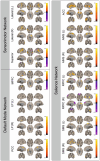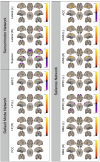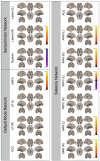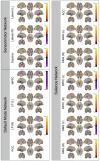Attenuation of the BOLD fMRI Signal and Changes in Functional Connectivity Affecting the Whole Brain in Presence of Brain Metastasis
- PMID: 38893128
- PMCID: PMC11171012
- DOI: 10.3390/cancers16112010
Attenuation of the BOLD fMRI Signal and Changes in Functional Connectivity Affecting the Whole Brain in Presence of Brain Metastasis
Abstract
To date, there are almost no investigations addressing functional connectivity (FC) in patients with brain metastases (BM). In this retrospective study, we investigate the influence of BM on hemodynamic brain signals derived from functional magnetic resonance imaging (fMRI) and FC. Motor-fMRI data of 29 patients with BM and 29 matched healthy controls were analyzed to assess percent signal changes (PSC) in the ROIs motor cortex, premotor cortex, and supplementary motor cortex and FC in the sensorimotor, default mode, and salience networks using Statistical Parametric Mapping (SPM12) and marsbar and CONN toolboxes. In the PSC analysis, an attenuation of the BOLD signal in the metastases-affected hemisphere compared to the contralateral hemisphere was significant only in the supplementary motor cortex during hand movement. In the FC analysis, we found alterations in patients' FC compared to controls in all examined networks, also in the hemisphere contralateral to the metastasis. This indicates a qualitative attenuation of the BOLD signal in the affected hemisphere and also that FC is altered by the presence of BM, similarly to what is known for primary brain tumors. This transformation is not only visible in the infiltrated hemisphere, but also in the contralateral one, suggesting an influence of BM beyond local damage.
Keywords: blood oxygenation level-dependent imaging; brain metastasis; functional connectivity; functional magnetic resonance imaging; percent signal change.
Conflict of interest statement
The authors declare no conflicts of interest.
Figures









Similar articles
-
Network-specific resting-state connectivity changes in the premotor-parietal axis in writer's cramp.Neuroimage Clin. 2017 Oct 14;17:137-144. doi: 10.1016/j.nicl.2017.10.001. eCollection 2018. Neuroimage Clin. 2017. PMID: 29085775 Free PMC article.
-
Effective Connectivity of Cortical Sensorimotor Networks During Finger Movement Tasks: A Simultaneous fNIRS, fMRI, EEG Study.Brain Topogr. 2016 Sep;29(5):645-60. doi: 10.1007/s10548-016-0507-1. Epub 2016 Jul 20. Brain Topogr. 2016. PMID: 27438589
-
Re-examine tumor-induced alterations in hemodynamic responses of BOLD fMRI: implications in presurgical brain mapping.Acta Radiol. 2012 Sep 1;53(7):802-11. doi: 10.1258/ar.2012.120118. Epub 2012 Jul 31. Acta Radiol. 2012. PMID: 22850572
-
Investigating the effects of healthy cognitive aging on brain functional connectivity using 4.7 T resting-state functional magnetic resonance imaging.Brain Struct Funct. 2021 May;226(4):1067-1098. doi: 10.1007/s00429-021-02226-7. Epub 2021 Feb 18. Brain Struct Funct. 2021. PMID: 33604746 Review.
-
Comparison of blood-oxygen-level-dependent functional magnetic resonance imaging and near-infrared spectroscopy recording during functional brain activation in patients with stroke and brain tumors.J Biomed Opt. 2007 Nov-Dec;12(6):062110. doi: 10.1117/1.2823036. J Biomed Opt. 2007. PMID: 18163813 Review.
Cited by
-
From Tumor to Network: Functional Connectome Heterogeneity and Alterations in Brain Tumors-A Multimodal Neuroimaging Narrative Review.Cancers (Basel). 2025 Jun 27;17(13):2174. doi: 10.3390/cancers17132174. Cancers (Basel). 2025. PMID: 40647472 Free PMC article. Review.
-
Shared subcortical arousal systems across sensory modalities during transient modulation of attention.Neuroimage. 2025 May 15;312:121224. doi: 10.1016/j.neuroimage.2025.121224. Epub 2025 Apr 16. Neuroimage. 2025. PMID: 40250641 Free PMC article.
References
-
- Cagney D.N., Martin A.M., Catalano P.J., Redig A.J., Lin N.U., Lee E.Q., Wen P.Y., Dunn I.F., Bi W.L., Weiss S.E., et al. Incidence and prognosis of patients with brain metastases at diagnosis of systemic malignancy: A population-based study. Neuro Oncol. 2017;19:1511–1521. doi: 10.1093/neuonc/nox077. - DOI - PMC - PubMed
LinkOut - more resources
Full Text Sources

